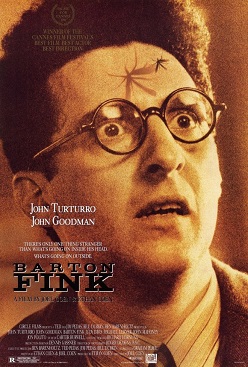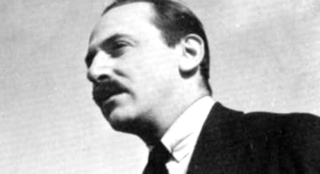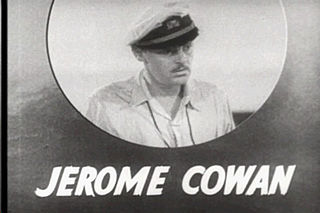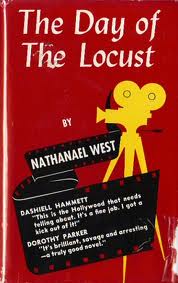
Homer Jay Simpson is a fictional character and the main protagonist of the American animated sitcom The Simpsons. He is voiced by Dan Castellaneta and first appeared, along with the rest of his family, in The Tracey Ullman Show short "Good Night" on April 19, 1987. Homer was created and designed by cartoonist Matt Groening while he was waiting in the lobby of producer James L. Brooks's office. Groening had been called to pitch a series of shorts based on his comic strip Life in Hell but instead decided to create a new set of characters. He named the character after his father, Homer Groening. After appearing for three seasons on The Tracey Ullman Show, the Simpson family got their own series on Fox, which debuted December 17, 1989.

Barton Fink is a 1991 American period black comedy psychological thriller film written, produced, edited and directed by the Coen brothers. Set in 1941, it stars John Turturro in the title role as a young New York City playwright who is hired to write scripts for a film studio in Hollywood, and John Goodman as Charlie Meadows, the insurance salesman who lives next door at the run-down Hotel Earle.

Nathanael West was an American writer and screenwriter. He is remembered for two darkly satirical novels: Miss Lonelyhearts (1933) and The Day of the Locust (1939), set respectively in the newspaper and Hollywood film industries.

High Sierra is a 1941 American film noir directed by Raoul Walsh, written by William R. Burnett and John Huston from the novel by Burnett, and starring Ida Lupino and Humphrey Bogart. Its plot follows a career criminal who becomes involved in a jewel heist in a resort town in California's Sierra Nevada, along with a young former taxi dancer (Lupino).
Eyvind Earle was an American artist, author and illustrator, noted for his contribution to the background illustration and styling of Disney's animated films in the 1950s. The Metropolitan Museum of Art, New York, Rahr West Art Museum, Phoenix Art Museum and Arizona State University Art Museum have purchased Earle's works for their permanent collections. His works have also been shown in many one-man exhibitions throughout the world.
The culture of Los Angeles is rich with arts and ethnically diverse. The greater Los Angeles metro area has several notable art museums including the Los Angeles County Museum of Art (LACMA), the J. Paul Getty Museum on the Santa Monica Mountains overlooking the Pacific, the Museum of Contemporary Art (MOCA), and the Hammer Museum. In the 1920s and 1930s Will Durant and Ariel Durant, Arnold Schoenberg and other intellectuals were the representatives of culture, in addition to the movie writers and directors. As the city flourished financially in the middle of the 20th century, culture followed. Boosters such as Dorothy Buffum Chandler and other philanthropists raised funds for the establishment of art museums, music centers and theaters. Today, the Southland cultural scene is as complex, sophisticated and varied as any in the world.

William Atherton is an American actor. He had starring roles in The Sugarland Express (1974), The Day of the Locust (1975), The Hindenburg (1975) and Looking for Mr. Goodbar (1977), but is perhaps most recognized for his roles in Ghostbusters (1984), Die Hard (1988) and Ghostbusters: Frozen Empire (2024).

John Howard Payne was an American film actor who is mainly remembered from film noir crime stories and 20th Century Fox musical films, and for his leading roles in Miracle on 34th Street and the NBC Western television series The Restless Gun.

Jerome Palmer Cowan was an American stage, film, and television actor.
Paul Roger Hackett is a former American football coach. He served as head football coach of University of Pittsburgh from 1989 to 1992 and at the University of Southern California (USC) from 1998 to 2000. Hackett was quarterbacks coach or offensive coordinator for the San Francisco 49ers, Dallas Cowboys, Kansas City Chiefs, Cleveland Browns, New York Jets, Tampa Bay Buccaneers, and Oakland Raiders.

Julia Faye Maloney, known professionally as Julia Faye, was an American actress of silent and sound films. She was known for her appearances in more than 30 Cecil B. DeMille productions. Her various roles ranged from maids and ingénues to vamps and queens.

The Day of the Locust is a 1975 American satirical historical drama film directed by John Schlesinger and starring Donald Sutherland, Karen Black, William Atherton, Burgess Meredith, Richard Dysart, John Hillerman and Geraldine Page. Set in Hollywood, California, just before World War II, the film depicts the alienation and desperation of a disparate group of individuals whose dreams of success fail to come true. The screenplay by Waldo Salt is based on the 1939 novel of the same title by Nathanael West.

Musso & Frank Grill is a restaurant located at 6667-9 Hollywood Boulevard in the Hollywood neighborhood of Los Angeles. The restaurant opened in 1919 and is named for original owners Joseph Musso and Frank Toulet. It is the oldest restaurant in Hollywood and has been called "the genesis of Hollywood."
I Stole a Million is a 1939 film noir crime film starring George Raft as a cab driver turned small-time crook who makes a big score and lives to regret it. The supporting cast includes Claire Trevor, Dick Foran, and Victor Jory. The movie was written by Nathanael West based on a story idea by Lester Cole, which in turn was based on the life story of bank robber Roy Gardner. It was directed by Frank Tuttle, and released by Universal Pictures.
Hans Habe was a Hungarian and American writer and newspaper publisher. From 1941, he held United States citizenship. He was also known by such pseudonyms as Antonio Corte, Frank Richard, Frederick Gert, John Richler, Hans Wolfgang, and Alexander Holmes.
Frank Edgington Fenton was an American writer of screenplays, short stories, magazine articles, and novels.
The Pacific Coast Professional Football League (PCPFL), also known as the Pacific Coast Football League (PCFL) and Pacific Coast League (PCL) was a professional American football minor league based in California. It operated from 1940 through 1948. One of the few minor American professional sports leagues that competed in the years of World War II, the PCPFL was regarded as a minor league of the highest level, particularly from 1940 to 1945, at a time in which the National Football League (NFL) did not extend further west than Chicago and Green Bay. It was also the first professional football league to have a team based in Hawaii.
John Sanford or John B. Sanford, born Julian Lawrence Shapiro, was an American screenwriter and prose writer who wrote 24 books. The Cambridge Companion to Jewish American Literature describes him as, "Perhaps the most outstanding neglected novelist." A one-time member of the Communist Party, after he and his wife Marguerite Roberts refused to testify to the House Un-American Activities Committee, they were blacklisted and unable to work in Hollywood for nearly a decade.
Stanley Rose was an American bookseller, literary agent, and raconteur, whose eponymous Hollywood bookshop, located adjacent to the famous Musso & Frank Grill restaurant, was a gathering place for writers working or living in and around Hollywood. Rose's most notable literary associates were William Saroyan, to whom he was variously a friend, a drinking and hunting companion, and a literary representative; and Nathanael West, whose 1939 novel The Day of the Locust owed much of its “local color” to its author's acquaintance with Rose.









